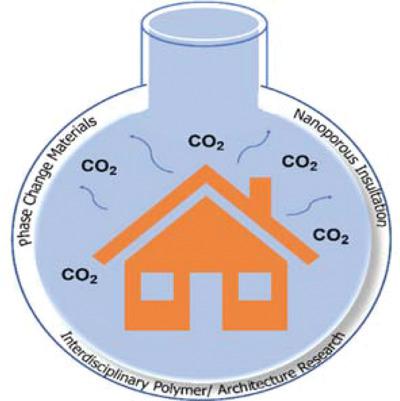当前位置:
X-MOL 学术
›
Macromol. Rapid Commun.
›
论文详情
Our official English website, www.x-mol.net, welcomes your
feedback! (Note: you will need to create a separate account there.)
Advanced Polymers for Reduced Energy Consumption in Architecture
Macromolecular Rapid Communications ( IF 4.2 ) Pub Date : 2018-11-22 , DOI: 10.1002/marc.201800597 Katherine V. Heifferon 1 , Timothy E. Long 1
Macromolecular Rapid Communications ( IF 4.2 ) Pub Date : 2018-11-22 , DOI: 10.1002/marc.201800597 Katherine V. Heifferon 1 , Timothy E. Long 1
Affiliation

|
In an effort to slow the progress of climate change, the current scientific community has focused on the reduction of greenhouse gases in order to limit the global average temperature inflation to less than 2 °C. The improvement of thermally controlled construction materials can potentially result in lower energy homes/reduced emissions, and lowering the thermal conductivity of insulation materials improves home energy efficiency. Nanoporous insulation foams impart a drastic decrease in thermal conductivity but many polymer properties must be assessed to produce these materials. Passive phase‐change materials also represent another key energy‐saving device to control heat flux within a living space. Research into unique polymeric systems provides a novel means of encapsulation or creating polymeric cross‐linked matrices to prevent leakage and improve mechanical robustness. These two areas of polymer research in architecture represent key advancements for construction materials aimed toward energy savings and energy‐related emissions control.
中文翻译:

用于降低建筑能耗的先进聚合物
为了减缓气候变化的进程,当前的科学界集中于减少温室气体,以将全球平均温度膨胀限制在2°C以下。热控建筑材料的改进可以潜在地减少家庭能源消耗/减少排放,降低隔热材料的导热系数可以提高家庭能源效率。纳米多孔绝缘泡沫会大大降低热导率,但是必须评估许多聚合物的性能才能生产这些材料。被动相变材料还代表了另一个重要的节能装置,可控制居住空间内的热通量。对独特的聚合物系统的研究提供了一种新颖的封装方法或创建聚合物交联基体的方法,以防止泄漏并提高机械强度。建筑学领域的聚合物研究的这两个领域代表了建筑材料在节能和与能源有关的排放控制方面的关键进展。
更新日期:2018-11-22
中文翻译:

用于降低建筑能耗的先进聚合物
为了减缓气候变化的进程,当前的科学界集中于减少温室气体,以将全球平均温度膨胀限制在2°C以下。热控建筑材料的改进可以潜在地减少家庭能源消耗/减少排放,降低隔热材料的导热系数可以提高家庭能源效率。纳米多孔绝缘泡沫会大大降低热导率,但是必须评估许多聚合物的性能才能生产这些材料。被动相变材料还代表了另一个重要的节能装置,可控制居住空间内的热通量。对独特的聚合物系统的研究提供了一种新颖的封装方法或创建聚合物交联基体的方法,以防止泄漏并提高机械强度。建筑学领域的聚合物研究的这两个领域代表了建筑材料在节能和与能源有关的排放控制方面的关键进展。











































 京公网安备 11010802027423号
京公网安备 11010802027423号